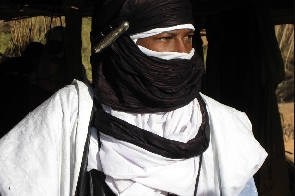Among the Tuareg, it is the veil that distinguishes between an adult and a young person. When one assumes adulthood, he can wear the face veil with a silver veil weight attached. A boy is given his first veil when he turns 20 years old. Women are given a veil when they get married.
Anthropologist Ines Kohl describes the initiation ceremony where the veil is given to the boy as “anagad”. A feast is held where relatives and neighbors are called on to observe the initiation ceremony. A sheep or goat is killed and religious scholars recite the first verse of the Koran.
The male child will be provided with his first Tagelmust by his father or maternal uncle and he is obligated to wear it for one week, day and night without parting ways with it even once. The face veil is part of the Tuareg culture. A man’s veil is referred to as Tagelmust in the Tamashek, the local dialect of the Tuareg while a woman’s veil is known as adeko or afar, according to Horniman Museum and Gardens.
There are various schools of thought on why the Tuareg wear the face veil. For some, it is to offer protection against the dust and sand in the desert while others wear it for religious purposes and protection against an evil eye, according to a study cited by Horniman Museum and Gardens.
The Tuareg believe that the veil protects them also from the spirits of the dead called Kel Eru who could take over the soul of anyone traveling through the desert. Traditionally, the Tuareg dye their veils with indigo, which stains their skins. They are sometimes known as the blue people after their traditional indigo dyes.
Generally, the face veil is worn by many for decorative purposes. However, a man is expected to cover his brow, nose and mouth in the presence of strangers, especially mothers-in-law. In the case of women, they draw their veil over their mouths in the presence of their fathers-in-law.
Anthropologist Kohl argued that the lowering or raising of the face veil to hide the mouth is a sign of respect shown by the wearer to whoever he or she is speaking with. The veil is raised a bit high as a sign of politeness. It is also considered that, if a man does not cover his brows, nose and mouth, he is exposing himself to the effects of an evil eye or mouth.
These traditionally nomadic pastoralists are part of North Africa’s Berber ethnic confederation that inhabits the Sahara from far southwestern Libya to southern Algeria, Niger, Mali and Burkina Faso.
The Taureg are known to have dominated trade in the trans-Saharan routes and, as passionate promoters of Islam, oversaw the booming of Timbuktu. Tuaregs refer to themselves as Kel Tamasheq, meaning speakers of Tamasheq, as well as Kel Tagelmust, meaning veiled people.
Africa News of Saturday, 21 January 2023
Source: face2faceafrica.com

















